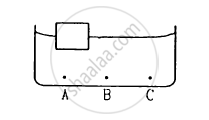Advertisements
Advertisements
प्रश्न
Is it always true that the molecules of a dense liquid are heavier than the molecules of a lighter liquid?
उत्तर
Density is defined as mass per unit volume. It tells how closely packed are the molecules inside an object. When molecules are tightly packed, we say that the object is dense; when molecules are far apart, we say that the object is light.
The density of a liquid depends on the mass of the molecules that make up the liquid and the closeness of the molecules of the liquid. It is not always true that the molecules of a dense liquid are heavier than the molecules of a lighter liquid.
For example, alcohol is less dense than oil. Alcohol molecules are mostly carbon and hydrogen atoms, so they are similar to oil. But they also contain an oxygen atom, which makes them a little heavy. For this reason, you might think that alcohol is denser than oil. But because of their shape and size, alcohol molecules do not pack as efficiently as oil molecules. This property of molecules makes alcohol less dense than oil.
APPEARS IN
संबंधित प्रश्न
A glass of water has an ice cube floating in water. The water level just touches the rim of the glass. Will the water overflow when the ice melts?
Water is slowly coming out from a vertical pipe. As the water descends after coming out, its area of cross section reduces. Explain this on the basis of the equation of continuity.
A liquid can easily change its shape but a solid can not because
A wooden object floats in water kept in a beaker. The object is near a side of the beaker . Let P1, P2, P3 be the pressures at the three points A, B and C of bottom as shown in the figure.

A closed cubical box is completely filled with water and is accelerated horizontally towards right with an acceleration α. The resultant normal force by the water on the top of the box
Water enters through end A with a speed v1 and leaves through end B with a speed v2 of a cylindrical tube AB. The tube is always completely filled with water. In case I the tube is horizontal, in case II it is vertical with the end A upward and in case III it is vertical with the end B upward. We have v1 = v2 for
Find the ratio of the weights, as measured by a spring balance, of a 1 kg block of iron and a 1 kg block of wood. Density of iron = 7800 kg/m3, density of wood = 800 kg/m3and density of air = 1.293 kg/m3.
A wooden block of mass 0.5 kg and density 800 kg/m3 is fastened to the free end of a vertical spring of spring constant 50 N/m fixed at the bottom. If the entire system is completely immersed in water, find the elongation (or compression) of the spring in equilibrium .
A wooden block of mass 0.5 kg and density 800 kg/m3 is fastened to the free end of a vertical spring of spring constant 50 N/m1 fixed at the bottom. If the entire system is completely immersed in water, find the time-period of vertical oscillations of the block when it is slightly depressed and released.
